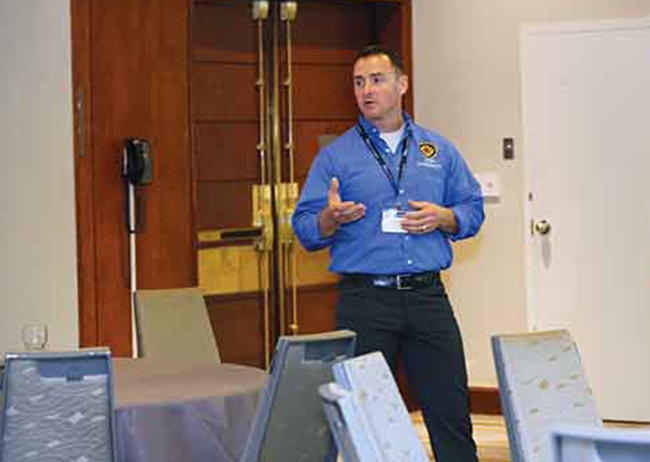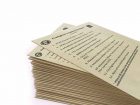
Firefighter preplan
Maria Church
Features Hot Topics Inside The HallOn Feb. 4, 2007, Winnipeg firefighter Lionel Crowther experienced what no firefighter ever wants to experience – he was badly burned.
 Winnipeg firefighter Lionel Crowther was burned in 2007. He says the lack of an organized system for contacting family and dealing with paperwork added to an already stressful situation. Toronto Fire Services has formalized the processes that would take place in the event a crew member is severely injured on the job. By Maria Church
Winnipeg firefighter Lionel Crowther was burned in 2007. He says the lack of an organized system for contacting family and dealing with paperwork added to an already stressful situation. Toronto Fire Services has formalized the processes that would take place in the event a crew member is severely injured on the job. By Maria ChurchIt was Super Bowl Sunday and Crowther, then 33, was called in to Winnipeg Fire Paramedic Service’s station 1 for the night shift. Outside it was -48 C with the windchill.
Crowther arrived at the station around 6 p.m. and was assigned to engine 101. He and the rest of the crew gathered in the break room to catch the game. At 7:30 p.m., the first call came in for a house fire, followed shortly by a second call. Engine 101 was tasked as rescue.
The garage of the house was fully involved when Crowther’s truck arrived third in; he and his buddy, Scott (Scotty) Atchison, gear checked and made entry.
Crowther recalls that the door was open, the lights and the TV were on, and there was light smoke and a little heat. Fire investigators later determined that the garage door into the house was left slightly ajar. Crowther and Atchison had just climbed the stairs to the bedrooms when a radio call came in to evacuate.
“We didn’t feel it was urgent at first,” Crowther said of the call. But when thick black smoke appeared, he turned to make it down the stairs and was met with a fireball.
“It came up the stairs at us,” he said, “we were in the flow path.”
Crowther turned around to head back into the bedrooms when he was knocked down (later thought to be by one of the other firefighters).
“I got up and everything was hot,” he said. “My fingers were tingling.”
That’s when he started to panic. With his SCBA face piece blackened from the heat, Crowther fumbled his way to a window and began banging with his fist.
“It felt like concrete. It felt like a wall,” he said. Crowther’s fist finally broke the glass, creating a new flow path for the flames. “My knees were burning, my hands were burning; it felt like I was in the middle of the fire, but I couldn’t see anything.”
By this time the rapid intervention team (RIT) members were making their way into the house with a 2 1/2-inch hoseline. Team members made it to the stairs where they retrieved one downed firefighter, Edward Wiebe. Atchison was able to smash through a window in another room and make it out onto the roof.
Meanwhile, Crowther managed to widen the window opening, and bumped into another firefighter, Capt. Harold Lessard, who was on his knees in bad shape. Crowther leaned down to grab Lessard and get him out the window. As Crowther did so, the super-heated gases in his PPE compressed onto his own skin, and he screamed out in pain.
Crowther continued struggling to lift Lessard, and eventually boosted him to standing position. Crowther then twisted himself out the window and fell five metres. Finally, he felt nothing.
“All of the pain was gone,” Crowther said. “Not sure if it was because it was so cold outside or if I was in shock.”
Two RIT members climbed a ladder to retrieve Lessard; working slowly, they were able to lift him up and out of the window. Crowther, Lessard, Atchison, and firefighter Darcy Funk were all taken to the hospital. Lessard and Capt. Thomas Nichols, another member who was caught in the flashover, did not survive. Within 23 minutes, the Winnipeg department lost two members and had four others with severe burns.
What happened following the incident was perhaps even harder for Crowther, he said.
“Operationally it affected the department, but for my family and myself, we were not prepared for it,” he said. “I thought I would never get burned. I know it seems silly, but I thought it would never happen.”
At the Winnipeg Health Sciences Centre, doctors determined Crowther had burned 70 per cent of his body and required skin grafts to 20 per cent. He was expected to lose three fingers and to spend months in the hospital recovering.
But Crowther was lucky, or blessed, he said. The firefighter spent just 17 days in hospital, retained all fingers, and today appears unscarred. He went back to work 10 months later.
Looking back, Crowther said he wishes he could have prevented some of the stress his family went through during all stages of his injury and recovery. Ideally, he said, there would have been a plan in place for how his family learned about his condition.
“All those things like who is going to contact my family, who is going to take care of them, all those things that could have been preplanned, if I was unconscious, it never would have been done,” Crowther said.
“We can learn from incidents like this,” he said. “These are the things that we want to preplan for.”
Creating a plan
Toronto fire captain and union executive officer Geoff Boisseau is one of the primary organizers of the annual Canadian Burn Symposium for first responders. Crowther shared his story at the 2015 symposium in Toronto, the second annual.
An overarching goal that has grown out of discussions at the burn symposium is to create a protocol for firefighter-emergency situations, including burns. The idea is to have information packages available to all firefighters on staff that include contact information for next of kin/spouses, workers’ compensation paperwork and contacts and medical records of the firefighter to submit to doctors and nurses.
“It’s a way to protect the injured worker,” Boisseau said. “There would be everything to make sure the paperwork is done, and make sure that they are protected and they understand their rights.”
The International Association of Fire Fighters (IAFF) has a comprehensive burn program that includes burn-fund assistance. Applications must be submitted through the IAFF member’s local affiliate president within 14 days from the date of burn. But, especially in the case of a bad burn or emergency such as Crowther’s, the family won’t likely be thinking about paperwork, Boisseau said. Workers compensation requirements, too, involve complicated protocols and particular deadlines.
After working on the project for close to a year, Boisseau, along with Toronto firefighter Ken Webb, created a firefighter incident envelope that will be available to all Toronto Fire Services’ chiefs officers in the event of an emergency. The package includes forms for workers’ compensation, modified duties, suspected exposure, critical injury, burn-injury notification protocols and Mandatory Blood Testing Act (steps to take in the event of possible cross-contamination of blood). A straightforward checklist in the package identifies what needs to take place when, to make sure all of the bases are covered.
“This way everything is all in one envelope,” Boisseau said. “It’s a sealed envelope. You rip it open when you get [to the hospital], and you know you have everything.”
The forms, according to Toronto Fire Services’ protocol, are handled by a safety designated officer (a designated officer, as required by the Ontario Ministry of Health, with additional safety responsibilities), who arrives at the hospital with the injured firefighter or shortly thereafter. Webb, who was Toronto’s safety designated officer until last June, said immediate access to all forms would expedite the process.
Many of the required forms are now online, Webb said, “but when you’re in hospital, the online version isn’t overly helpful because you aren’t able to capture the information you need.”
As a supplement to the incident envelope, Toronto Acting Capt. Ken Dejong, working with assistance from Boisseau, spearheaded a comprehensive next-of-kin notification system for severe injuries.
Directions for something as simple as whom to contact first in the event of an emergency can help prevent emotional damage in the long run, Dejong said. Some firefighters might prefer to have a relative or family friend notified first and have that person directed to tell a spouse to provide emotional support.
Dejong said he first began thinking about next-of-kin notification when he heard Crowther’s story at a conference and wondered what would Toronto Fire Services do for him in that situation. If he was unconscious, who would tell his wife, and how would anyone even know how to reach her?
“I’m trying to put myself, for all scenarios, in the position of the spouse and the family members,” Dejong said.
Many volunteer, composite and career departments have some type of death/injury notification training or system in place, but they vary in complexity. In Ontario, Township of Centre Willington Fire Chief Brad Patton said his department has accident report forms in every station, and sensitive medical and contact information for each firefighter is kept under lock and key. Firefighters with Salt Spring Island Fire Rescue in British Columbia have their information in sealed envelopes that are stored in the duty vehicle at all times.
Dejong, seeking a homegrown way to formalize next-of-kin notification, spoke with officials in his department to find out what protocols were in place, and what was missing. The firefighter then sat down with Boisseau and Toronto Deputy Chief Darrell Reid in early January to create next-of-kin packages for Toronto firefighters.
The optional packages are filled out by each firefighter and contain directions on who to notify in the event of an emergency, appropriate contact methods (for example, work phone, cell, text message), and a custom action plan, which could include everything from directions for transporting the family to the hospital or asking a neighbour to feed the cat. Once filled out, the documents are placed in sealed envelopes and stored at Toronto Fire Services communications centre to be accessed in the event that a firefighter is unconscious.
“We want the families to be informed as much as possible, and to get there safely to the hospital,” Dejong said, “Once things are settled and they are protected and all of their immediate needs are taken care of, then the rest of it unfolds properly.”
All but the final details of both the incident packages and next-of-kin notification envelopes were approved in late February by the city and firefighters union. Dejong and Boisseau said they hope similar systems are in place, or replicated across the country in volunteer, composite and career departments, and they are more than willing to share the templates.
Support system in place
In career departments, and some unionized volunteer halls, after the first few days of uncertainty following a firefighter injury, the association will take care of almost everything, Dejong said.
The IAFF burn injury assistance program is comprehensive and includes burn co-ordinators across North America who facilitate firefighters participation in burn prevention, fire safety, burn care and survivor support activities.
Phil Tammaro, an IAFF burn co-ordinator from Massachusetts, was at the burn symposium in Toronto and said the network of survivors is possibly the most important aspect of the IAFF’s program.
“Most people don’t understand the full effects of burn injuries – the short-term
impacts and the long-term impacts,” Tammaro said. For firefighters, they must choose whether or not to go back into a profession in which they were harmed, he said.
“There’s a loss of identity if they can’t go back into that job, or if they don’t want to,” Tammaro said.
It was at a burn-survivor event organized by the IAFF that Crowther first found relief from his long-term suffering. He later was invited to give a talk about his experience, along with his wife, Joanna, at the New Brunswick Association of Fire Chiefs conference. The response to their talk, Crowther said, was overwhelming.
“We were pretty honest about how it affected, not just us, but our marriage and our kids,” he said. “A burn is not a temporary injury, it’s a lifelong injury and we had to come to terms with that.”
In Canada, Crowther is a member of the Canadian Burn Survivors Community, which has been active since 2007. After years of participating in and helping out with support programs, Crowther said he is in a good place to help other firefighters who are injured on the job. The firefighter is working with Dejong, Boisseau and officials in his own department to implement a similar firefighter incident package.
“Our chief, John Lane, is from Toronto so hopefully with his contacts in Toronto, with Boisseau and all the guys there, hopefully we can work together to make a really great program that can spread across Canada,” Crowther said.
To learn more about Toronto’s incident packages and next-of-kin notification, contact Boisseau at boisseau@torontofirefighters.org
Canadian burn co-ordinators
Michael Brackenreed Alberta
British Columbia Northwest Territories Yukon Saskatchewan
6thdistrictburn-
foundation@iaff.org
Lionel Crowther
Manitoba Ontario
13thdistrictburn-foundation@iaff.org
Robert Macleod
New Brunswick Newfoundland and LabradorNova Scotia P.E.I. and Quebec
15thdistrictburn-foundation@iaff.org
James Dansereau
All federal firefighters of Canada and the United States
16thdistrictburn-foundation@iaff.org
Print this page

